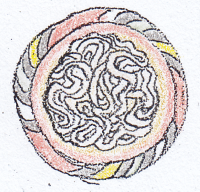Paróbaxi
Barp: Paróbaxóm
Afnat: Akn Barap
The paróbaxi1 are native to the region of Paróbax in the Búxó Peninsula of western Emlas. They are divided into several city-states across the peninsula, some warlike and others which trade with people as far as southwestern Emlas and the Beml Islands to the north.
Fish, crustaceans and mollusk is generally seen as food for commoners, while the aristocracy prefers wild game and other food found inland, sometimes to the point of avoiding seafood altogether, especially killer whales, which are considered sacred.
In general, water oats are mostly used for stews or porridge, millet for bread and acorns are made into noodles, often served in broth or fish oil. Acorn noodles in fish oil
Trident adorned with barkcloth fibers
Afnat: Akn Barap
The paróbaxi1 are native to the region of Paróbax in the Búxó Peninsula of western Emlas. They are divided into several city-states across the peninsula, some warlike and others which trade with people as far as southwestern Emlas and the Beml Islands to the north.
Society
Paróbaxi society is matrilineal and has a very clear distinction between the upper and lower classes, though the exact things such as clothing and types of housing used to distinguish the two varies between city-states, as is the power of their rulers; some are absolute monarchies, others are essentially oligarchies.Culture
Apparel
Paróbaxi clothing differs between regions and castes, with bark-cloth being common inland and hairs of sanxean wool dogs2 used elsewhere, particularly to the west. Aristocrats display their status by wearing large capes or cloaks fastened with a jade pin, and bark-cloth hats adorned with pearls or abalone beads.Art
Like other cultures of eastern Emlas, the paróbaxi live in wooden longhouses of varying size and quality. Generally, those on the Berop Plain to the northwest and along the coast have either thatched or wooden roofs, while those up in the mountains are made with bark shingles.Cuisine
Although paróbaxi grow water oats, millet and (particularly to the east) oak trees for acorns, wild game and seafood are an important part of their diet, such as boars, salmon and eulachon. Other common produce includes lettuce, radishes and beans.Fish, crustaceans and mollusk is generally seen as food for commoners, while the aristocracy prefers wild game and other food found inland, sometimes to the point of avoiding seafood altogether, especially killer whales, which are considered sacred.
In general, water oats are mostly used for stews or porridge, millet for bread and acorns are made into noodles, often served in broth or fish oil. Acorn noodles in fish oil
Language
The paróbaxi speak several closely related languages which together form a language family which is an isolate. Originally written using sanxean script, it's since been mostly replaced by a new one originally created in Akat in southeastern Paróbax, called barp, which fits their languages better than the foreign sanxean one. Unlike the latter, the characters in barp are made up entirely of straight lines and triangles.Religion
Each paróbaxi city-state has its own pantheon of deities associated with sacred trees, mountains and animals (especially bears and killer whales), which are honoured by leaving offerings at their shrines or by ritual dancing and music performed by shamans.
The most important shrines are those carved out of whole redwood trees, the greatest of which have gradually become the center of entire temple complexes to store sacred paraphernalia used by shamans for various ceremonies, especially those connected to agriculture, hunting and war.
The most important shrines are those carved out of whole redwood trees, the greatest of which have gradually become the center of entire temple complexes to store sacred paraphernalia used by shamans for various ceremonies, especially those connected to agriculture, hunting and war.
Warfare
While relatively few in number, paróbaxi warriors (and, in some places, warrioresses) are some of the fiercest in western Emlas, particularly those in the northern and western city-states who often need to keep pirates from the Beml Islands at bay.Trident adorned with barkcloth fibers








Comments